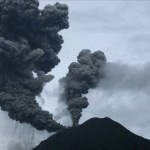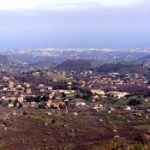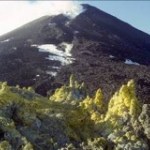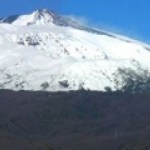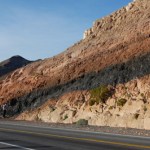Etna
Classes starting today, so I have to be brief:
Unique twin ash plumes from Sinabung in Indonesia, erupting on August 29, 2010.
Sinabung
The Indonesian volcano continues to experience explosions, which one last night (well, last night here in Ohio) that prompted an ash advisory for aircraft up to 6,100 m / 20,000 feet, although most reports I've seen pegged the ash column at closer to 2,000 m / ~6,500 feet. Eruptions readers have found a bevy of links for footage and information about the eruption, including a remarkable image gallery from the BBC that shows the volcano exhibiting two ash…
Sorry about the lack of posts - I've been not only frantically prepping for class and my Eyja talk, but also I'm somewhat under the weather with an ill-timed sickness, so even though there is stuff to talk about, I haven't really had time/wherewithal to deal with it.
However, expect big things from Eruptions next week!
Drawing of a ship washed inland by the tsunami generated by the August 27, 1883 eruption of Krakatau.
I'll throw a few quick links:
The alert status at Galeras has been dropped back down to "orange" after the non-explosive eruption earlier this week. However, INGEOMINAS warns…
Today was a doubleheader for volcanic eruptions in the news:
Today's explosive eruption from Mt. Etna. Image courtesy of the INGV.
As I briefly mentioned earlier, Galeras in Colombia had an "atypical" eruption - apparently meaning it was non-explosive - that has prompted evacuations and a change in the alert status to "Red" for the volcano. Various news sources don't have a lot of new information yet, but you can check on the report on the INGEOMINAS page (spanish) - and they have links to some of the Galeras news (audio, spanish) from their main page. Some of the latest reports from…
The final part of Etna Week, brought to us by guest blogger Dr. Boris Behncke. Check out Part 1 and Part 2 as well!
Etna Volcanic hazards
By guest blogger Dr. Boris Behncke.
Etna is one of the most active volcanoes on Earth, and a population of nearly one million people dwell on its flanks, many in areas that have been repeatedly invaded by lava flows during the historical period. A few villages have been constructed very close to the vents of eruptions only a few hundred years old.
Top: Residential areas surrounding numerous pyroclastic cones on the lower southeast flank of Etna, seen…
This is Part 2 of 3 from guest blogger Dr. Boris Behncke. Check out Part 1 here.
The current dynamics and activity of Etna
by guest blogger Dr. Boris Behncke
The recent behavior of Etna is characterized by nearly continuous eruptive activity from the summit craters and eruptions from new vents on the flanks at intervals of a few years to decades. Summit eruptions vary from quiet lava emission to mild Strombolian explosions to high-discharge-rate Hawaiian to sub-Plinian style lava and fire fountaining accompanied by the emplacement of fast-moving lava flows; usually the strongest activity…
Etna Week Part 1
Mount Etna - Brief Anatomy of an Exceptional Volcano
By guest blogger Dr. Boris Behncke.
Italy truly deserves to be called "the Cradle of Volcanology" - not only because it hosts virtually all existing types of volcanoes and volcanic rock compositions, and seven of its volcanoes have had confirmed eruptions during the historical period (i.e. the past approximately 2700 years), but also because the earliest surviving eyewitness account of an eruption was written in Italy, the first volcano observatory and the first geothermal power plant were built in Italy, and three…
Italy's Mt. Etna erupting in November 2006.
Well, I am currently off in the wilderness, but that doesn't mean that things aren't still hopping here at Eruptions. We are lucky to have Dr. Boris Behncke of the INGV Catania as that blogger and he brings us a three-part series on Mt. Etna on the island of Silicy. That means this week is Etna Week here on Eruptions, so for all of you chomping at the bit for more information on the Italian volcano, you are going to get it (and then some).
modern-day satellites who can watch that same summit from space.
I think you're all going to love this series…
Lava flows from Kilauea in Hawai`i move towards a home in Kalapana.
Whenever I think about the hazards posed by most lava flows, I tend to think about the opening scene in the Hitchhiker's Guide to the Galaxy. Developers are planning to knock our hero Arthur Dent's house down and as a last ditch effort to stop its destruction, Arthur lies down in front of the bulldozer. The demolition supervisor, a certain Mr. Prosser, at one point asks Arthur if he knows how much damage the bulldozer might suffer if he just lets it roll over poor Mr. Dent. Arthur says he doesn't know and Mr. Prosser replies…
A view of the steaming Mt. Etna, taken on April 8, 2010 by Dr. Boris Behncke.
Eruptions reader and member at Italian National Institute of Geophysics and Volcanology in Catania, Dr. Boris Behncke, has been keeping many of us appraised on the goings-on at Mt. Etna. A series of earthquakes occurred on April 2-3 along a fault near the north flank of the volcano - 175 earthquakes in all producing some impressive results - and Boris has noted increased "rumblings" at Etna since. This has culminated in explosions and ash April 7-8. Most of the ash appears to be made from merely crushed rock of…
I'm still playing catch-up after my week in the desert, so I've seen a lot of articles I've wanted to mention ... but a certain other volcano has taken up a lot of my time. However, I will attempt to make amends for that now.
By the way, would you believe Ubehebe Crater was closed? How do they close a volcano, anyway? However, I did get a great snap of a welded tuff on the road outside of Shoshone, CA.
A strongly welded tuff near Shoshone, CA. The dark interior is remelted volcanic ash/tephra surrounded by less welded pink tuff with abundant pumice clasts. Denison student David Sisak is on…
News!
Pakistan is home to the world's tallest mud volcano in the region of Balochistan - and its somewhat near the reports of an "eruption" earlier this week.
Guess what? Since Wednesday evening, seismicity at Yellowstone has dropped precipitously. The last batch of earthquakes on February 3rd were also back to deeper levels - 8-9 km depth - compared to the potential shallowing earlier in the week. I'm sure the caldera will keep us on our toes, but as of now, it seems to have settled down a bit.
Over in Pakistan, there is mounting evidence that the recent "volcanic" eruption reported as, in…
Here is Part 2 of the Q&A with Dr. Boris Behncke. You can also check out Part 1.
Undated image of Stromboli in eruption.
(Shirakawa Akira) 1. Would a large scale eruption (VEI 5 or greater) of Mt. Etna like the ones occurred in 122 BC and 1500 BC (disputed) be possible again in the foreseeable future? Or is the volcano slowly "dying" although the last eruption ended in July 2009 has been one of the longest ever recorded?
2. Not really related to volcanism, but close: does INGV plan to distribute seismic data from seismic stations of its Rete Sismica Nazionale, including stations from…
First off, I want to thank Dr. Behncke for taking the time to answer your questions - and also, thank you to all who sent him some thought-provoking questions. In fact, the questions and answers take up about 12 pages of text, so the Q&A will be divided into two parts.
If you want to see one of the previous in the Q&A series, check out:
Dr. Jonathan Castro.
Question and Answer with Dr. Boris Behncke of the Italian National Institute of Geophysics and Volcanology in Catania.
Dr. Boris Behncke.
Questions for Dr. Boris Behncke
(Bernard Duyck) Qu'en est-il de l'évolution du mécanisme…
The volcanoes of Italy must have known that Dr. Boris Behncke would be in the Q&A spotlight here at Eruptions because three have shown signs of new activity over the last week. Here is a quick summary based on information from Dr. Behncke and Sonia Calvari of IGVN.
Etna erupting in 1989. Image by Dr. Boris Behncke.
Etna
On November 6, Etna in Italy appears to have entered a new phase of activity. The volcano had not produced any explosive events since July 4, 2009, but since 11/6, Etna has experienced a series of deep-seated explosive events - some of which suggest there is a lava lake…
Just a reminder ...
Etna erupting in November 2002.
If you have any questions for Dr. Boris Behncke, who runs Italy's Volcanoes along with the volcanology page for the Italian National Institute of Geophysics and Volcanology in Catania, please send them in to me at
. I've got some good question so far!
The first Q&A with Dr. Jonathan Castro was such a success, I'm going to try to make this a regular feature. On that note, Eruptions reader Dr. Boris Behncke has volunteered to be the second geologist to take the plunge. Here is a little about Boris and his work:
I've studied geology first in Bochum, Germany, then finished my Master's in Kiel, Germany (in 1996), before hopping south to Catania, where I did my Ph.D. in 2001. I live in Sicily since early 1997, but first visited the Italian volcanoes in 1989, and happen to be at Etna when it produced a spectacular eruption just on schedule.…
We've already talked about how many active volcanoes reside in Indonesia, but this week's USGS/SI update just drives that point home. Listed in the update are no less than 5 volcanoes were activity is being seen or is on the increase (Karangetang, Slamet, Dukono, Batu Tara and Makian). This doesn't mean mention the activity at Anak Krakatau, Rinjani or Semeru. Amazing.
Anyway, highlights - not counting Indonesia or the South American trio - from this week's report (as usual aptly put together by Sally Kuhn Sennert) include:
A ~8,000 foot / 2.4 km ash and steam plume from Bagana in Papua New…
Ulawun Volcano, Papau New Guinea, one of the "Decade Volcanoes"
There was some discussion earlier about the so-called "Decade Volcanoes", so I thought I'd elaborate a bit on them (doubly so in light of certain other lists.) These volcanoes are defined by IAVCEI - the International Association of Volcanology and the Chemistry of the Earth's Interior - and are part of a program whose aim is
"to direct attention to a small number of selected, active volcanoes world-wide and to encourage the establishment of a range of research and public-awareness activities aimed at enhancing an…
Its been a busy week for volcanoes between the headline capturing Tongan and Alaska eruptions. Catch up on what you might have missed with the latest SI/USGS Weekly Volcano Report (for 3/18-3/24). Highlights (beyond Hunga Tonga Hunga Ha'apai and Redoubt) include:
Galeras, Colombia has settled down a bit
More block-and-ash flows from the two dome complexes growing at Chaiten, Chile
Strombolian eruptions at Mt. Etna, Italy
Plumes of steam and minor ash were reported from Popocatépetl, Mexico
A small lahar was seen at Tungurahua, Ecuador
Ash plumes and incandescent tephra explosions were…
Over the weekend, Mt. Etna (Italy) had some spectacular Strombolian fire-fountaining. Lucky for us, Marco Fulle and a group went up to the summit on Friday (the 13th) and got some great pictures of the current (ongoing) eruption which have been posted on Stromboli Online. Sounds like the eruption has been increasing in the past week, so it could be a busy summer in the Aeolian Island of Italy.
